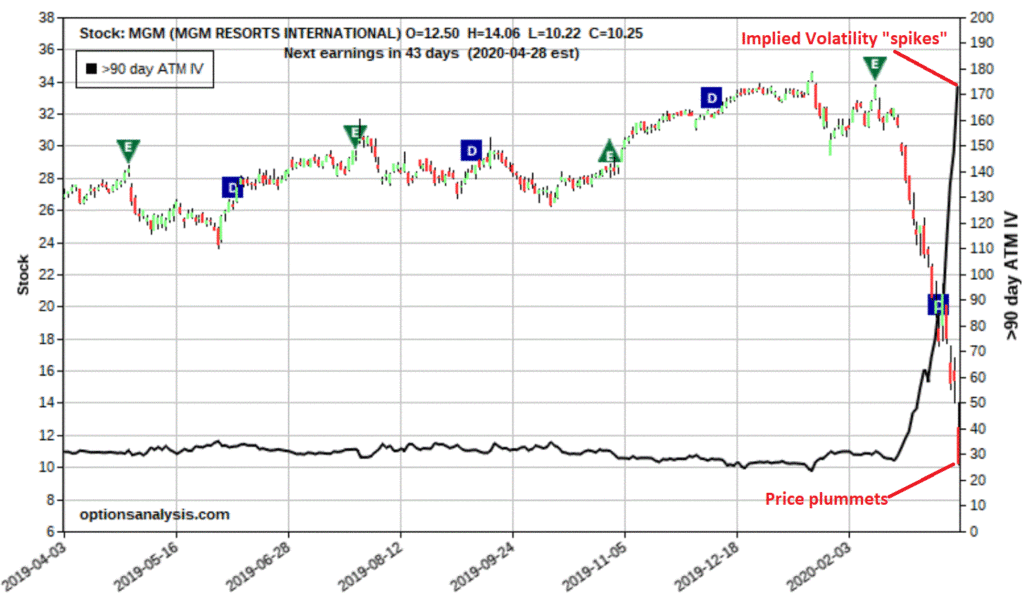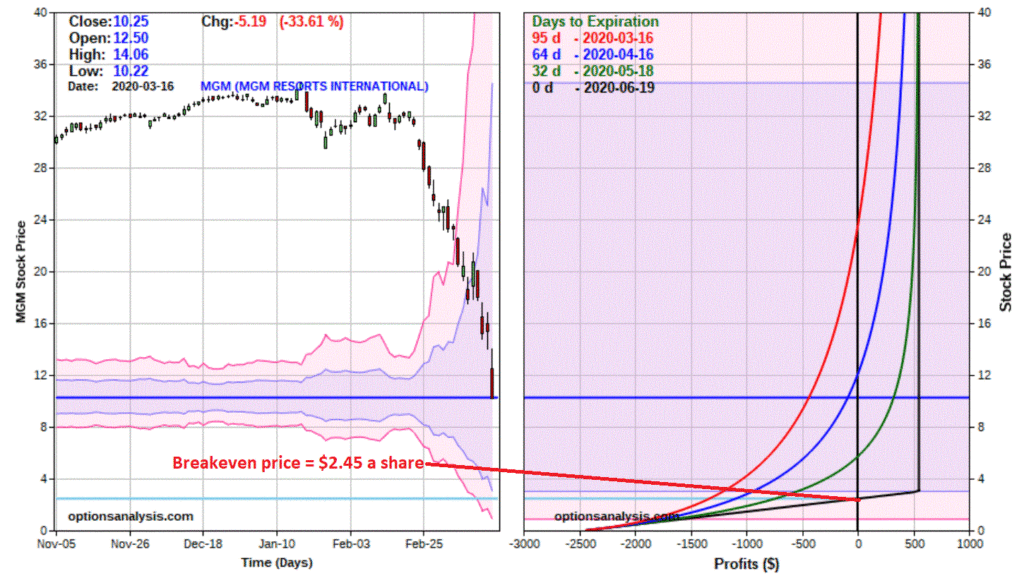The fear associated with “current events” has pushed the implied volatility for options on many stocks to staggeringly high levels. This creates the potential – and please make careful note of the word “potential” – to sell out-of-the-money put options as a way to, a) generate income, and/or b) buy stock at well below current levels.
See also A Glimpse of Just How Oversold this Market Is
IMPORTANT NOTES:
*I am not recommending that anyone pursue the strategy I am highlighting (it’s known as a cash secured put) – it is presented merely as “one way to play” in an extremely volatile market clouded in nearly unprecedented uncertainty. Every trader has to learn the pro’s and con’s and decide for themselves.
*The purpose of the strategy in these articles is to sell far out-of-the-money options when implied volatility – and thus time premiums – are exorbitantly high, and to hopefully buy them back when IV abates. However, being required to buy the shares if necessary is part of the deal.
*That being said, the goal of the strategy discussed in these articles is not really to “accumulate shares of stock at below current price levels” (although that is one common use for this strategy), rather the belief (hope?) is that someday the cloud of panic will abate – if only temporarily – and that implied volatility levels will plummet from their current stratospheric heights, and many put options will collapse in price as time premium evaporates (due solely to the decline in IV). At that point – ideally – the options can be bought back early at a profit rather than being held until expiration.
*My opinion is that this strategy should ONLY be used in a “cash secured” manner, i.e., you need to have enough cash in your account to buy the underlying stock at the strike price if necessary. DO NOT sell naked puts in this market on margin (again, just my opinion) – the risk in this environment is simply too great.
*If you are not willing to buy the underlying stock at the strike price – again, in my opinion – DO NOT sell cash secured puts. Why? Because if the price of the stock does decline you either typically have to ultimately buy the stock or buy back the put – most likely at a loss.
Now on to today’s idea.
Ticker MGM
Like the cruise line industry, the hotel and gaming industry is getting crushed by the impact of the coronavirus. Nobody knows what the full impact will be and the reality is that things are likely to get worse before they get better. But as I have said in the past, opportunity is where you find it.
Figure 1 displays the sharp decline in MGM stock AND the massive spike in implied volatility.

Figure 1 – MGM stock price plummets, MGM option implied volatility “spikes” (Courtesy www.OptionsAnalysis.com)
So far, MGM has tanked a full -70% since January 17, including an almost unbelievable -33.6% decline in one day on 3/16/20.
IMPORTANT NOTE: Under no circumstances would I consider buying shares of MGM stock at this point in time. That would be a classic potential case of trying to “catch a falling safe”. Trying to “pick a bottom” in this type of decline is simply foolhardy. But that is NOT what selling a cash secured put in this case is all about.
The example trade we will consider for MGM involves:
*Selling 10 June 3 puts @ $0.55
*This action takes in $550 worth of premium ($0.55 x 100 shares x 10 puts)
*The trader needs to have $3,000 in cash in the account to cover the potential purchase of the 1,000 shares of stock if need be (this can include the $550 of premium received, so the investor needs to put up another $2,450 in cash)
Figures 2 and 3 display the particulars and the risk curves for this trade.

Figure 2 – MGM secured put particulars (Courtesy www.OptionsAnalysis.com)

Figure 3 – MGM secured put risk curves (Courtesy www.OptionsAnalysis.com)
Note that the implied volatility for this option as this is written is an astronomical 248.5%! In the prior four years (see the most recent 12 months in Figure 1) the typical range for MGM 90-day option IV was 25%-45%.
Other things to note:
*There are 95 days left until option expiration – we are hoping for a significant decline in IV sometime between now and then
*The option is trading at $0.55 bid/$0.95 ask. This is an exceedingly wide bid/ask spread. A trader could use a limit order and try to get filled at a price above $0.55. For sake of simplicity we are assuming a fill using a market order at the bid.
*MGM (as this is written) is trading at $10.25 a share. The breakeven price for this position is $2.45, another -76% below the current price.
The possible outcomes:
*If MGM completely collapses, we could end up buying 1,000 shares at $3.00 apiece. But remember, since we took in $0.55 for each option, we sold our effective buy price is $2.45 a share ($3.00 – $0.55 = $2.45)
*Worst case scenario, MGM goes bankrupt, the shares go to $0 and we lose the full $2,450 at risk
*The most likely outcome (hopefully) is that, either:
a) in 95 days, MGM is still above $3 a share the options expire worthless and we keep the $550 in premium. This works out to a 22.5% return ($550 return / $2,450 cash held to secure the put options) in just 95 calendar days
b) Somewhere along the way implied volatility – and thus the price of the option – plummets, and we can buy back the option early and a price below $0.55 per option.
The bottom line? If MGM does ANYTHING better than collapsing another 76% in 3 months this trade stands to make a decent return.
Now comes the real question: Is this actually a good idea? As with the previous examples, that’s not for me to say.
Jay Kaeppel
Disclaimer: The information, opinions and ideas expressed herein are for informational and educational purposes only and are based on research conducted and presented solely by the author. The information presented does not represent the views of the author only and does not constitute a complete description of any investment service. In addition, nothing presented herein should be construed as investment advice, as an advertisement or offering of investment advisory services, or as an offer to sell or a solicitation to buy any security. The data presented herein were obtained from various third-party sources. While the data is believed to be reliable, no representation is made as to, and no responsibility, warranty or liability is accepted for the accuracy or completeness of such information. International investments are subject to additional risks such as currency fluctuations, political instability and the potential for illiquid markets. Past performance is no guarantee of future results. There is risk of loss in all trading. Back tested performance does not represent actual performance and should not be interpreted as an indication of such performance. Also, back tested performance results have certain inherent limitations and differs from actual performance because it is achieved with the benefit of hindsight.

